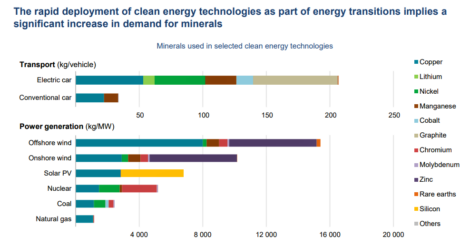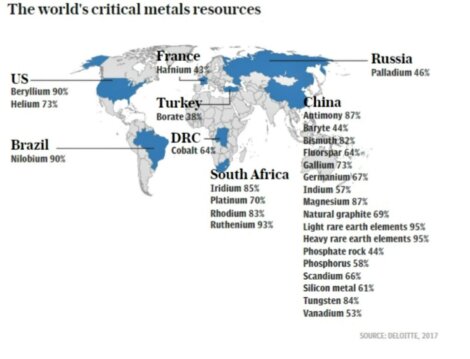Viewpoint / Transition to net zero? It is a dirty road ahead
THE GREAT rush to ‘tackle climate change’ and ‘save the planet’ by decarbonisation requires an exponential growth in the use of the so called ‘renewable’ technologies, but it also means the need for critical minerals, metals, steel, and concrete vastly greater than that required for fossil fuel production, writes Allen Fraser.
The vast and urgent increased demand for these materials will severely impact commodities markets and prices as well as the environment. The blinkered ‘transition’ policies being pursued by national (UK) and local (Scottish Government and Shetland Islands Council) completely fail to consider the cost and volume of the increased demand of materials and future environmental impacts.
The demand
As an example, scaling up to wind will require about a ten-fold increase in the required tonnage of concrete and steel as well as other materials compared to a natural gas power plant of the same output (For 100MW output see Figure 1.)
For Viking Energy’s 443MW windfarm of 103 turbines we can conservatively multiply tonnages in Figure 1 by four giving: 120,000 tonnes of iron ore; 200,000 tonnes of concrete; 3,600 tonnes of non-recyclable plastics; 4,000 tonnes of critical metals and copper; 50 square miles of central mainland.
None of these figures include thousands of tonnes of construction materials and metals used to build and install the huge converter station in Kergord or its interconnector cable. Nor do they include the construction of buildings in Lerwick to house the tens of thousands of tonnes of batteries require to store and control the output.
The worldwide demand for building materials, critical minerals, and metals will increase much, much, more than ten-fold with the mad rush to switch to electric vehicles (EVs) and heat pumps. Electric cars require six times the metals of a conventional car (Figure 2). If the envisaged switch to two-thirds EVs on the road as new car purchases by 2030 is to happen, then dozens of new mines, each equivalent to the largest in the world today will be required to open, their ores processed and metals manufactured.
According to the International Energy Agency, to fulfil the terms of the 2015 Paris Agreement a shift of world energy from small-impact hydrocarbon-drilling and refining, to vast-impact, mineral mining, transport, and manufacture will be required. This will be necessary to meet the increased demand for minerals such as lithium, graphite, nickel, and cobalt rare earths by 4,200%, 2,500%, 1,900% and 700%, respectively, by 2040.
Research by the Geological Survey of Finland considered a full transition scenario, that is using wind and solar to electrify all vehicles and produce hydrogen for aviation and chemical processes. They concluded that for production to meet demand for most critical minerals would not only exceed existing and planned global production but exceed known global reserves.
Environmental impact
The quest for ‘net zero’ by going down the road of wind and solar power generation will create a demand for tens of gigatons of materials for construction, manufacture, grid expansion and storage and vehicle batteries.
To produce one ton of a critical metals, a vast tonnage of earth overburden must first be removed to extract the ore-rock, the amount of overburden will depend on locality and ore concentration. The extracted ore rock must be crushed and processed to obtain the metal.
For example, copper ore rock will typically contain just 0.5% copper metal – 200 tons of ore rock has to be dug up, crushed, concentrated and extracted to obtain one ton of copper. According to the World Economic Forum, the average cost of producing copper has risen by over 300% in recent years, while copper ore grade has fallen by 30%.
Neodymium is a rare earth element, which is essential for wind turbines, will require mining between 20 and 160 tons of ore to produce one ton of metal. Cobalt (used in most batteries) requires at least a staggering 1,500 tons of ore to produce just one ton of the element.
Almost none of these critical minerals are mined in Europe and none in the British Isles (Figure 3). China is the main source region critical minerals and turbine parts depend on imports from China. China is where almost all batteries are made, and mineral components from other regions are exported to China for their manufacture.
Mining by necessity is a dirty business, and in more ways than one. In many areas of the world mines producing these minerals often have a dreadful environmental reputation where they ravage landscapes, pollute water supplies desolate crops and exploit and displace communities.
Apart from its diabolical human rights record, China has an appalling environmental mining record leaving a trail of destruction and pollution where ore extraction has occurred, for example millions of tonnes of toxic waste are discharged into the Yellow River every year.
In neighbouring Myanmar illegal mines, bankrolled by Chinese money, use the Chinese methods of deforestation followed by strip mining or tunnelling to extract minerals by injecting sulphuric acid into the rock strata. This method of mining has left 3,000 acid lakes across the country blighting crops and poisoning water supplies. The market for the Myanmar critical metals is China to produce magnets for wind turbines and electric vehicles. Myanmar is now one of the biggest global producers of rare earth minerals.
Not just China, mining horror stories can be found in just about any of the source regions. In the Democratic Republic of the Congo 40,000 children work in appalling hazardous conditions in their cobalt mines – cobalt bound for China and ultimately for EV batteries. Mining in Brazil destroys rainforests and communities as well as illegal logging for balsa wood to make internal frames for turbine blades Corruption is rife in many ‘third world’ mining areas and no doubt some advanced countries as well.
Mining requires huge volumes of waste in the form of liquid mud called ‘tailings’ containing mixture of chemicals, minerals, and water – sometimes radioactive. At mines tailings are held back by dams – research shows that due to poor maintenance and monitoring the failure rate of these dams in one in every hundred, and there are hundreds of dams.
I have no doubt that there are many well run and environmentally conscious mining operations in the world, but at a high financial cost compared to the irresponsible ones. As demand for critical metals and rare earth minerals increases, lower grade ores become economic the financial incentive to be less environmentally responsible will increase.
Mining and ore extraction and the production of the resultant metals is a very energy intensive business and is estimated to be responsible for up to 7% of global greenhouse gas emissions – a figure that will continue grow as demand for metals increases rapidly and will outstrip best efforts to decarbonise, especially in mining countries that show little environmental concern.
When that is added to the production of all the industrial components such as magnets and batteries and all the other construction materials and processes in building and maintaining a giant windfarm, its actual carbon footprint is a massive unknown quantity. This situation will only get worse as the offshore wind industry expands across the North Sea.
To extract critical metals from the ore rock industry uses vast quantities of sulphuric acid. Sulphuric acid is manufactured from sulphur, which is waste product extracted from oil and gas to reduce emissions of sulphur-dioxide gas to the atmosphere. Industries also need sulphuric acid to produce phosphorus fertilisers for agriculture. The fossil fuel industry provides 246 million tonnes of sulphuric acid annually – to meet the net zero mining targets and intensive agriculture this will need to rise to 400 million tonnes by 2040 and 570 million tonnes by 2050.
Demand will necessitate mining of sulphur deposits in volcanic areas of the planet, the reserves of which are still largely unknown – more mining means larger carbon footprint and more runoff pollution. Demand for sulphuric acid will drive up its price, putting the ‘green’ energy in competition with farming so greatly increasing the cost of food production and any move away from meat.
Like the rest of the population that need the thousands of everyday products from hydrocarbons, the wind and solar industry can’t survive without an oil and gas industry, not just for sulphur but because they need plastics in manufacture and require large volumes of gearbox oil and grease for lubrication.
China is regarded as a ‘significant threat’ by the British Government. If China were to impose an export ban on rare earth mineral components, the wind industry would be in severe crisis (‘up a pole without a magnet,’ to coin a phrase). That is why mining companies are surveying much of Scotland, particularly the granite Highlands, for lithium and other critical minerals.
They are doing this with the intention to open mines if suitable ore grades are discovered – a requirement if we have our own supply of critical minerals as decreed by government energy policy. It is not out of the question that we could see vast strip mines across the scenic Highlands of Scotland (perhaps Shetland’s granites and pegmatites will become a mining target).
Elsewhere, Sweden and Norway intend to mine the Arctic regions and the Chinese are trying to get permission to open vast mines in Greenland. The ocean floor is a source of critical minerals and is now being targeted by mining companies.
If we see the Ronas Hill granite, the Sandsting granite or the whole west coast of Yell targeted for vast mining operations, the SIC and the Greens will have no reason to complain for they are happy to accept the metals obtained from Myanmar in our turbines and the cobalt from the child miners in the SIC’s EV fleet.
Shetland
It is clear to anyone who drives through the Lang Kames that Shetland Island Council (and councillor trustees at the time) led Shetland down the wrong road by endorsing the Viking Energy project and a connection to the national grid.
The alternative suggested by myself and others at the time was an off grid solution with a ‘fit for scale, fit for purpose’ wind farm in Shetland backed up by natural gas.
If this solution had been followed (with the addition of tidal), we wouldn’t have most of Shetland in fuel poverty and tied to the vagaries of the national grid and the big power companies – and we would now be something closer to ‘net zero’ than we can possibly get by endorsing large scale onshore and offshore wind.
Once again Shetland Islands Council is leading us down the wrong and dirty road by endorsing the Orion project and offshore wind that will close off some of the most prolific fishing grounds in the world.
In the background to SIC policy is the threat to bird and marine life posed by on vast areas occupied by on and offshore giant wind farms. In the mad rush for wind, proper research has never been done on these and other long-term effects on the environment, even though there is evidence emerging of significant damage to bird and marine life.
Another emerging threat is that of microplastics shed into the environment by erosion of turbine blades. Microplastics carry a load of highly toxic poisons that is released in watercourses and the sea and into the food chain. Not surprisingly the wind industry is trying to play down and completely deny what may be a huge environmental disaster – this is not surprising; the construction industry did the same with asbestos and the motor industry with leaded petrol. A report on recent research from Norway just published has this headline “The researchers find microplastics everywhere. In the air, in the water – and in the breast milk of nursing mothers.”
I have no doubt that by taking us down another dirty road the SIC will obtain ‘net zero’ by destroying our economy, our landscape and by depopulation.
Allen Fraser is a committee member of Sustainable Shetland, the grassroots group campaigning against the Viking Energy wind farm, and a founding member of the Shetland Geological Society.
Sources
Integrating Clean Energy in Mining Operations: Opportunities, Challenges, and Enabling Approaches. Joint Institute for Strategic Energy Analysis.
Rewriting the rules for the digital age – 2017 Deloitte Global Human Capital Trends.
The Hard Math of Minerals by Mark P Mills – National Academies of Sciences, Engineering and Medicine. Arizona State University.
Total GHG Emissions of Major Metals and Mining Companies Worldwide by Revenue in 2021 – GlobalData.
Sulfuric acid: the next resource crisis that could stifle green tech and threaten food security https://theconversation.com/sulfuric-acid-the-next-resource-crisis-that-could-stifle-green-tech-and-threaten-food-security-186765
News report on the findings of the Norwegian Environment Agency on Microplastics. https://www.vg.no/nyheter/innenriks/i/9zqmap/fant-mikroplast-i-luft-og-vann-norge-rundt-miljoedirektoratet-bekymret
Daily Telegraph https://www.telegraph.co.uk/business/2023/01/20/green-revolution-fuelling-environmental-destruction/?fbclid=IwAR0NRvy7H7br3R3s_9kigvydXH8tff2On3Vq7WMiHYtbJ-hDzLP_FDw-FP8






























































